
Marcus-Michael Dunkmann
Schönfelder Weg 45
D-42699 Solingen
 |
8x11film.com Marcus-Michael Dunkmann Schönfelder Weg 45 D-42699 Solingen |
| TEL.: 0212 - 6454254, FAX.: 0212 - 6454255 | e-mail: info@8x11film.com |
| Die SPUR- und Kleinstbildquelle in Solingen | |
With this reel your existing 8x11mm negative and slide films can be developed using the JOBO 1500 developing tank. It is based upon the small and medium format reel for the JOBO 1500 system (DuoSet 1501) and was developed jointly by 8x11film in co-operation with Minox GmbH. This is the first genuine alternative to the original MINOX daylight developing tank that is no longer in production.
The product from JOBO have a reputation for extreme dependability and easy of loading and our transformation of the spiral does not change anything. Please read the instructions carefully to learn from our 12 months experience and testing to get the most out of this product and avoid damages to the spiral parts.
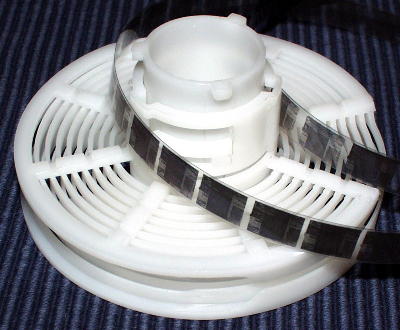
The development of an 8x11 film reel to use in the inversion tank has several advantages over the discontinued Minox daylight developing tank. 35mm and roll film can be developed with the same solution and at the same time depending on the choice of JOBO tank several reels can be loaded at the same time.
The same temperature and duration of processing follow those supplied by the manufacture of the film and of the developer. The same techniques for temperature control, inversion, tilting and processing that apply to conventional film can be followed.
With some skill and care is possible to develop two 36 exposure MINOX films on one reel. However we recommend that separate reels are used for each film to avoid the films moving and overlapping during the developing process. This is particularly a problem with films that have a strong tendency to curl. These may not be successfully developed at the out edge of the spiral.
The development in the rotation processor becomes possible with the 8x11 film spool but only with drastically lowered rotational speed. This is because the exposed area the negative strip, despite the large clearance between the adjacent parts of the spiral or helix can come into contact with it aided by the constant linear direction of flow of the developer in connection with turbulence at the outside edges of the spiral - both can lead to different velocities of flow and thus creating locally different effects of the developing chemistry. This phenomenon does not occur if the rotation is accompanied by tilting (please note however the tips for the coil of the film as well as for the movement of the tank during the process!). The use of the 8x11 film spool with the combined tilting rotation (e.g. JOBO Autolab) is under test.
![]()
The spool is composed four parts, as shown in the photograph:
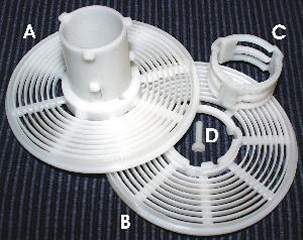 |
Part A.: the lower reel flange with the collar for the
central column to anchor the upper flange in place. Part B.: the upper reel flange Part C.: the bayonet locking collar Part D.: a plastic locking pin, which serves as fixture for the upper spiral to prevent twisting during loading and development.
|
First of all set the upper reel flange (B) on the centre tube fixed to the lower reel flange (A, picture left). The position of the bayonet pins are not symmetrical and the upper reel will have to be turned to slide into place. The upper reel flange must ultimately rest on the lower reel flange.
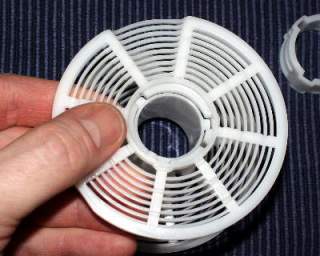 |
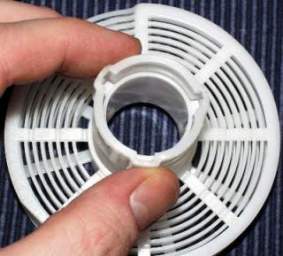 |
The bayonet locking (C) is put on in the same way. It will slide on in only one way, no force is needed. The narrower slots must be downwards towards the lower reel flange. Rotate clockwise, looking down, to firmly lock into place.
(G) The bayonet locking should not be twisted up to the end of the slot. It is sufficient to turn it so that the pins are centrally placed within the slots. (G)
![]()
The illustration left shows the correctly locked reel. The openings of both flange halves are positioned to face each other accurately (illustration right).
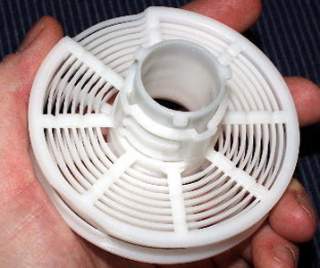 |
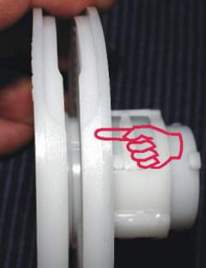 |
![]()
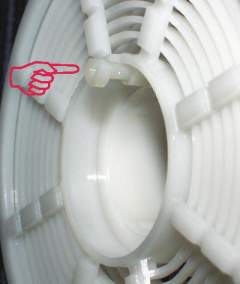 |
Insert the plastic locking pin (D) into the hole in the
base of the lower flange. The pin head is flat one side, this points out towards
the spiral so that it lies flush when fitted. In this position it locks the
upper flange. Push the reel over the centre tube, thus the head of the pin is
prevented from falling out. The reel is now ready for action.
|
![]()
(G) The JOBO developing tank is not for daylight loading, therefore all following steps up to locking the box with the transferred film must take place in absolute darkness! (G)
Remove the caps of the MINOX film cassette. These held in place by small clips. Carefully use a thumbnail to lift the caps away and pull off. If the film has not been wound through it may be easier to take both caps off.
Cut off the end of the film with the keyhole with sharp scissors and round the corners. If the corners are not rounded the film can hook itself then moving along the spiral.
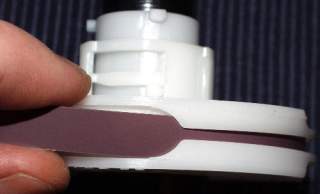 Tip: Use a clean porcelain plate as a dust free container
to layout all the small articles and aid in finding them by touch. Take the
prepared film in the left hand and the spool in the right. Feel for the reel
opening the right thumb and slowly slide the negative strip with the rounded off
end into the groove. By holding the negative strip with thumb and index finger
(as shown) push the film completely into the reel.
Tip: Use a clean porcelain plate as a dust free container
to layout all the small articles and aid in finding them by touch. Take the
prepared film in the left hand and the spool in the right. Feel for the reel
opening the right thumb and slowly slide the negative strip with the rounded off
end into the groove. By holding the negative strip with thumb and index finger
(as shown) push the film completely into the reel.
(G) It is recommended that the film be pushed completely into the reel. The fact that the reel has a narrower part tapering towards the centre exposes the edge of the film and so you can continue to hold the film along the edge and push towards the middle. Thus there are fewer pressure points on the film material with the spiral. With films of extreme coiling tendency this helps, along with small rotation and agitation of the tank to prevent under-development of the edges of the negative. (G)
Still in the dark insert the reel into the tank. Push on the lid and firmly push down the sealing and clamping ring. If done correctly the remaining steps can be done in daylight. It is advisable to practice these steps with out film in the daylight until you are confident of doing the same process in the dark with the film to be processed.
![]()
You can develop your film now according to manufacturer's instructions, (G) although we do recommend to deploy a particular motion technique of the tank (G), by which as even a washing of the film as is possible to be ensured during the process. This is necessary, since the film with the exposed negative area overlaps with the spiral of the reels and must also be well washed. In addition this helps to possibly carry away last bubbles of air stuck on the emulsion and is done in conjunction with the traditional inversion and taping of the tank.
Tilting agitation, as in holding the tank and rotating the wrist, is not sufficient. The developing tank should additionally be tilted and rotated so that the liquid is rotated around the vertical axis. This is similar to the movement of liquid in a cognac glass. This auxiliary movement needs to be performed at the beginning and along with minimum every second applied tilting rhythm.
It has no large influence on the developing time (depending on the sort of developer and the time of development). You may have to adjust the development times accordingly.
(G) Tilting time intervals by more than a half minute should be avoided! (G)
The developing solution with this reel must be at least 150ml and the reel must be positioned full down on the centre tube. When developing with several reels at the same time (8x11 and 35mm for example) the 8x11 reel should also be placed completely down on the centre tube.
Now follow the manufacturer's instructions for the use of a stop bath (to neutralize the developer) and fixer. The first washing is often done in the tank.
![]()
The washing should follow a fixing bath, for which distilled water with a minimum (!) additive of wetting agent should be used. Lift the reel from the developing tank, let the drips run off. Holding the lower flange in the left hand unlock the bayonet with the right hand and a twist anticlockwise. Do not twist the top flange as the pin is still in place. It will lift off easily when the bayonet locking collar has been removed.
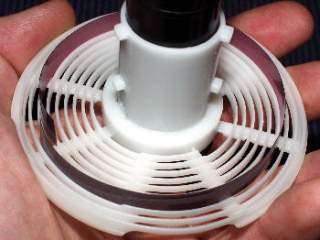 |
If you are using a large JOBO developing tank it is easier
to remove the reels from the centre tube first by pushing the tube downwards.
The film can now be removed to dry. Rinse all the reel parts off before the next
use with warm water and dry these carefully before storing.
|
![]()
We hope you have a successful start developing with the 8x11film-Reel but we are always grateful for suggestions and improvement. Technical specifications and guide are subject to change and correction. All rights reserved.
Last updated 31st August 2007.
Yours sincerely, Marcus Michael Dunkmann, 8x11film.com